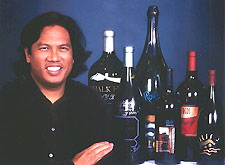|
from the Melting Pot of the Pacific
For many years in France - often considered the cradle of great winemaking - the answer was simple enough: it is the climat, the French word referring to the combination of soil and climate making up each individual vineyard. After that, the area where the influence of man plays a part becomes fuzzy. Many wine lovers, and many vintners, also consider the traditions associated with each vineyard - how the soil is tilled and fertilized, how the vines are trained, when and how the grapes are picked, and the countless human decisions required by the process of fermentation, aging, and finishing of each wine in the winery - to be very much a part of the concept of climat. Then there is the French word, terroir; which technically refers to the geographic factors associated with each vineyard, but like climat is also intrinsically tied to the traditions associated with each vineyard. This is why both words, terroir and climat, are often used interchangeably by winemakers and connoisseurs alike when talking about the character of wines from vineyards in France, from the greatest down to the most ordinary. Be as it may, it is the decisions made by human beings that explains why many people consider great winemaking to be as much an art as science. It is a science because great winemakers also have a great technical grasp of how vines respond to growing conditions, and how wines respond to vinification and aging regimes. But it is an art because of those thousands of decisions, or "moments of truth" as Roy Andries de Groot once put it, that growers and vintners face everyday, which end up making a difference between a plain, drinkable wine and a wine of great power and perfection. Great wine can indeed move a wine lover like a symphony, but perhaps a more appropriate analogy might be the culinary arts. Zillions of people can turn out a dish that tastes good; but we know that it takes rare intuition, imagination, mastery of technique and a bold, even brash personality to turn out a dish that excites us, and even changes the way we think about food. Like the pantheon of star chefs celebrated today in nearly every medium, star winemakers have come to epitomize the artistry associated with the greatest wines of the world. Not surprisingly, it is in the U.S., where concepts like terroir and climat are less firmly established than in Europe, that the personality and talent of the individual winemaker has become a stronger factor than even Mother Nature in the quality of wine. Year after year, for instance, a great American winemaker may rely on an individual vineyard to produce a signature wine. But in years when Nature refuses to smile on that particular vineyard - producing, instead, a meager crop of thin or unbalanced wine - a great winemaker can still turn around and blend wines from other vineyards, close by or faraway, and make something significant utilizing all the technical and aesthetic skills at his disposal. I've seen this done time and time again by Californians such as Jim Clendenen of Au Bon Climat, Tony Soter of Etude, and Miljenko ("Mike") Grgich of Grgich Hills. It's hard to keep a great winemaker down! So who are the great winemakers of today? Because of the technological advances in both the vineyard and wineries, in France great winemakers have become as celebrated as the country's chefs. In Bordeaux, for instance, the greatest personalities - such as Christian Moueix and Michel Rolland - inspire and direct small armies of other extraordinarily talented winemakers; while in smaller regions such as Burgundy, winemakers like Dominique Lafon and Francois Jobard work in more concentrated hands-on settings. Ultimately, though, in France it is the vineyards, not winemakers, that remain the overriding factor. Even the genius of men like Moueix and Lafon will never eclipse the fame and significance of a Chateau Petrus in Bordeaux, or a Montrachet in Burgundy. Elsewhere in the world, winemakers can, and often have, exerted more influence on the quality and character of wine than even the vineyards they work with. This, in spite of the fact that every great winemaker will also tell you that none of their work is possible without the use of great grapes from great vineyards. It is no coincidence that great grapes, vineyard sites and winemakers go hand in hand, since recognizing great material when he sees it - especially when few others see the same -- is part of what makes for a great winemaker. The following is a highly personal list of vintners I follow and admire the most. There are many, many others in this world, of course; but when you buy the wines crafted by these powerful personalities, you are almost guaranteed to get a wine of distinctive character. One that will inspire you, and even change the way you think about wine. Listed with the names of their estates or wineries, along with their particular regions, in parenthesis:
Feb. 12, 2002
|
 The Great Winemakers of Today
The Great Winemakers of Today